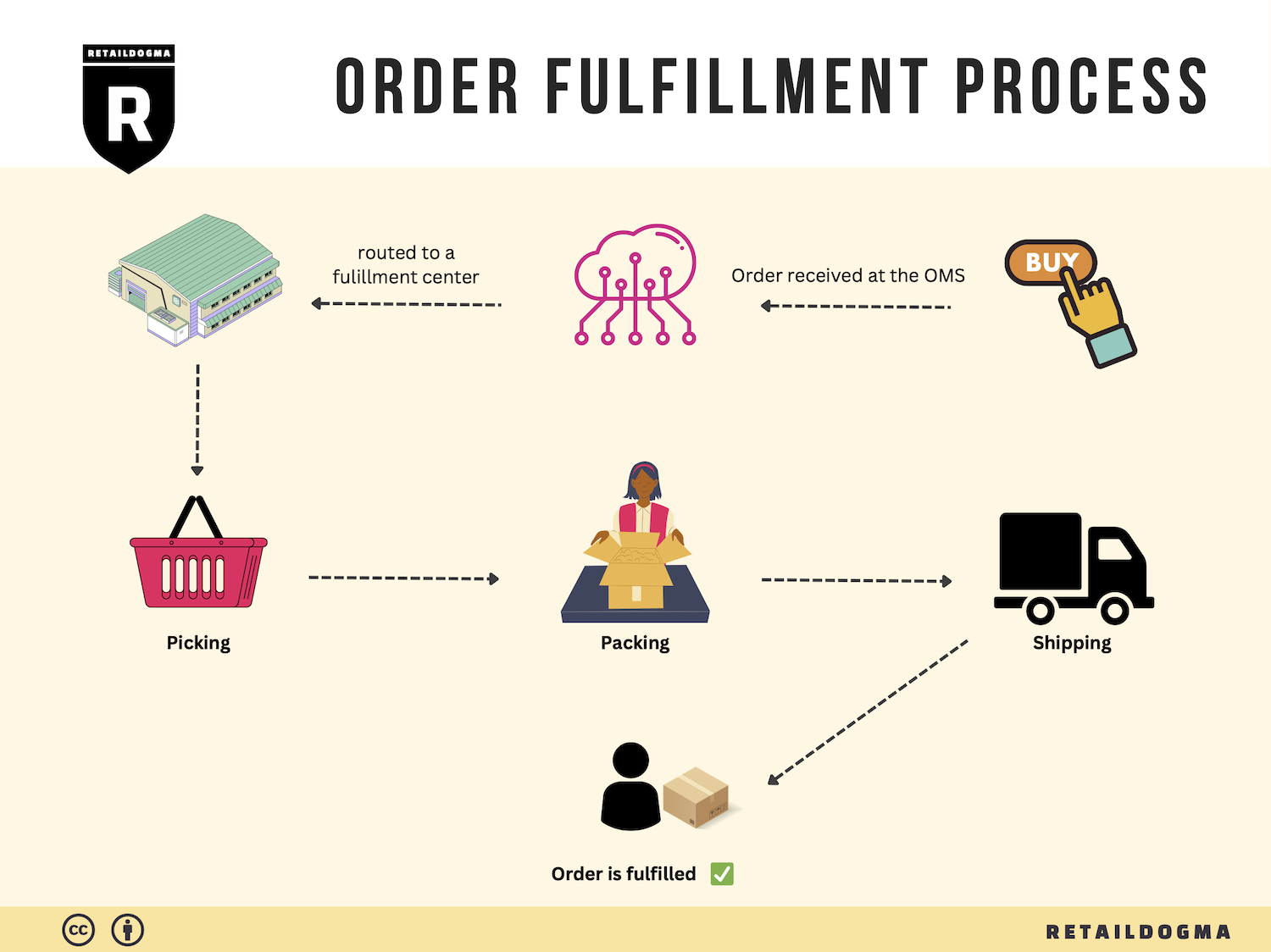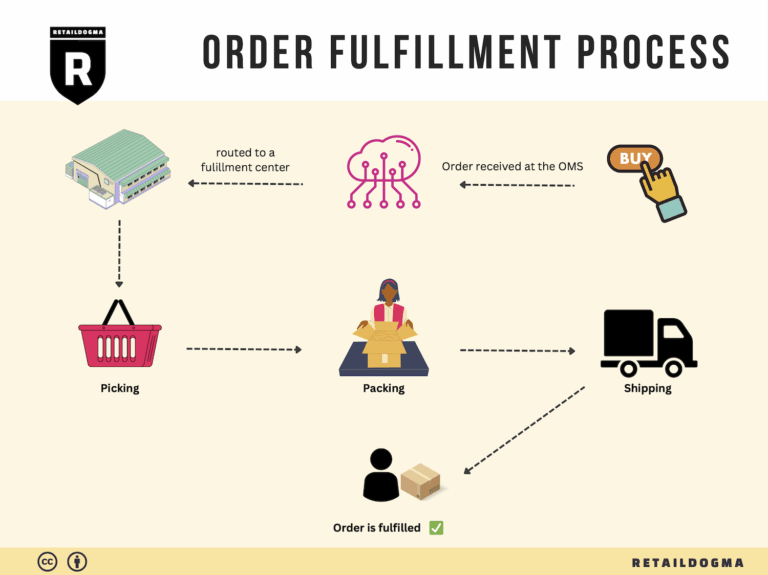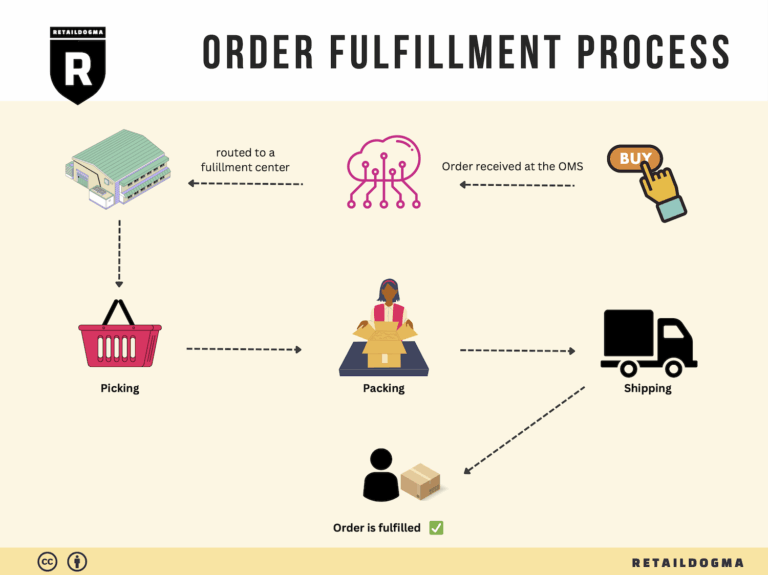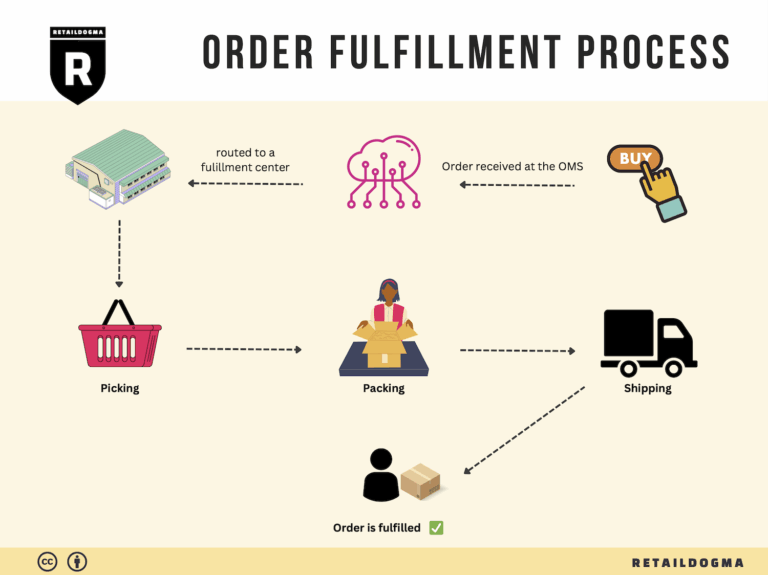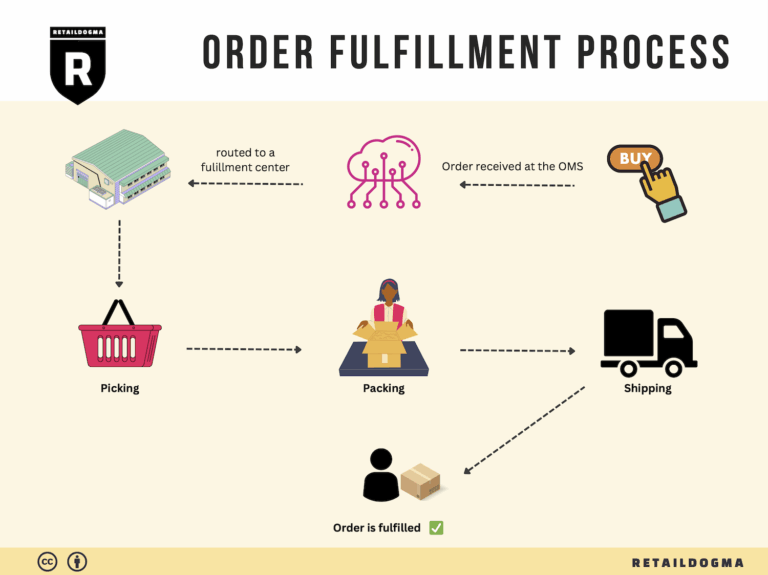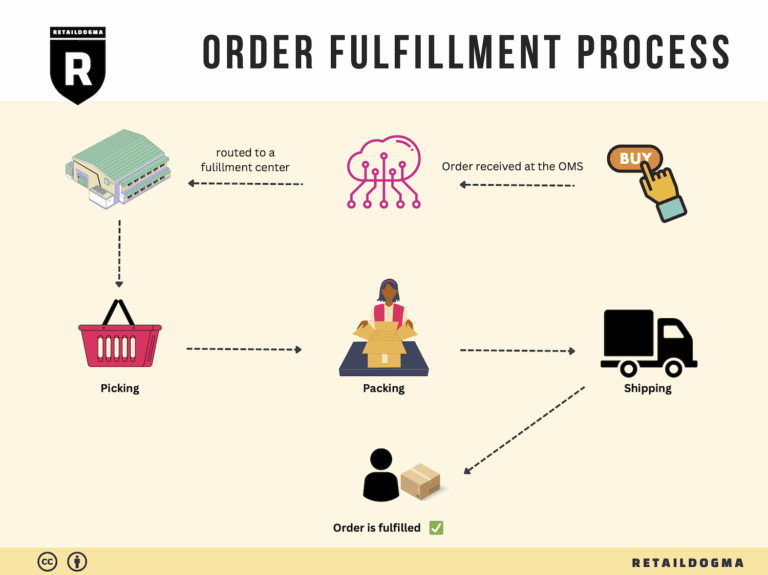What Is A Fulfillment Center? A Complete Guide (2025)
What is E-commerce Fulfillment? An Introduction for Growing Businesses
The Growing Pains of E-commerce: Navigating Fulfillment Challenges
As an e-commerce business owner or operations manager, you may find yourself grappling with a common pain point: the overwhelming task of packing and shipping orders. The excitement of growing sales can quickly turn into a logistical nightmare if you lack a streamlined process for fulfillment. Efficiently getting a product to your customer is not just about meeting demand; it’s about ensuring satisfaction and maintaining your brand’s reputation.
Fulfillment, in its simplest form, is the process of delivering products from your inventory to your customers. This encompasses everything from receiving orders to packing, shipping, and managing returns. For growing businesses, mastering this process is crucial to scaling operations effectively and sustainably.
In this guide, we will explore various models of e-commerce fulfillment that can help you optimize your logistics. We’ll cover Third-Party Logistics (3PL), Fulfillment by Amazon (FBA), and other alternatives, each with unique advantages and considerations. Understanding these models is vital for choosing the right fulfillment strategy that aligns with your business goals.
Additionally, we will delve into the core services typically offered by fulfillment centers, such as inventory management, order processing, and shipping logistics. Knowing what services are available can empower you to select a partner that meets your specific needs and can grow with you.
Choosing the right fulfillment partner is a critical decision that can significantly impact your business’s efficiency and customer satisfaction. We will provide practical tips on evaluating potential partners, including assessing their technology, scalability, and customer service capabilities.
Finally, we will address pricing structures associated with different fulfillment solutions. Understanding the costs involved will enable you to make informed financial decisions that support your growth without compromising service quality.

The goal of this guide is to empower you with the knowledge needed to make smart decisions about your logistics. By gaining a clearer understanding of e-commerce fulfillment, you can alleviate the stress of order management, enhance customer experiences, and ultimately drive your business toward greater success. Let’s dive into the world of e-commerce fulfillment and explore how to streamline your operations for growth.
What You’ll Learn In This Guide
- What is E-commerce Fulfillment? An Introduction for Growing Businesses
- The Order Fulfillment Process: From ‘Buy’ Button to Customer’s Door
- Comparing Fulfillment Models: In-House vs. 3PL vs. Dropshipping
- A Deep Dive into Amazon FBA: Pros, Cons, and Who It’s For
- Core Services Offered by Fulfillment Centers
- How to Choose a Fulfillment Partner: A 6-Point Checklist
- Understanding Fulfillment Pricing: A Breakdown of Common Fees
- Frequently Asked Questions (FAQs) about Fulfillment
- Conclusion: Is Outsourcing Fulfillment the Right Move for Your Business?
- Important Disclaimer
The Order Fulfillment Process: From ‘Buy’ Button to Customer’s Door
1. Receiving Inventory
The order fulfillment process begins with receiving inventory at the fulfillment center. When products arrive at the facility, they are unloaded and checked against purchase orders to ensure accuracy. This step is critical because it sets the foundation for the entire fulfillment process. Any discrepancies in quantity or quality can lead to delays in order processing and potential customer dissatisfaction.
During this phase, each product is typically assigned a Stock Keeping Unit (SKU), a unique identifier that helps in tracking inventory throughout the supply chain. Proper inventory management at this stage ensures that products are readily available for order fulfillment, which is essential for maintaining high service levels and meeting customer expectations.
2. Warehouse Storage
Once inventory is received and verified, it is stored within the fulfillment center. Effective warehouse storage strategies are crucial for maximizing space and ensuring efficient retrieval of products. Items are categorized and placed in designated storage areas based on various factors, such as product size, weight, and demand frequency.
Utilizing storage methods like pallet racking or shelving systems, the warehouse layout is designed for optimal accessibility. Key terms in this step include “ABC analysis,” which categorizes inventory based on its movement and importance. This method helps businesses prioritize storage space for high-demand items, reducing the time needed to locate products during order picking.
3. Order Picking
When a customer places an order, the next step is order picking, where items are retrieved from their storage locations. This step is crucial as it directly impacts the speed and accuracy of order fulfillment. Efficient picking processes help reduce lead times, ensuring that customers receive their orders promptly.
Businesses often utilize “pick lists,” which are generated based on customer orders and outline the specific items and quantities needed. Various picking methods can be employed, such as single order picking, batch picking, or zone picking, depending on the volume and nature of the orders. Implementing technology such as barcode scanners or mobile devices can enhance the picking process, reducing errors and increasing productivity.
4. Order Packing
After items are picked, they move to the packing station, where they are prepared for shipment. Packing is a vital step that ensures products are securely packaged to prevent damage during transit. This stage also includes labeling packages with shipping information and any necessary customs documentation for international orders.
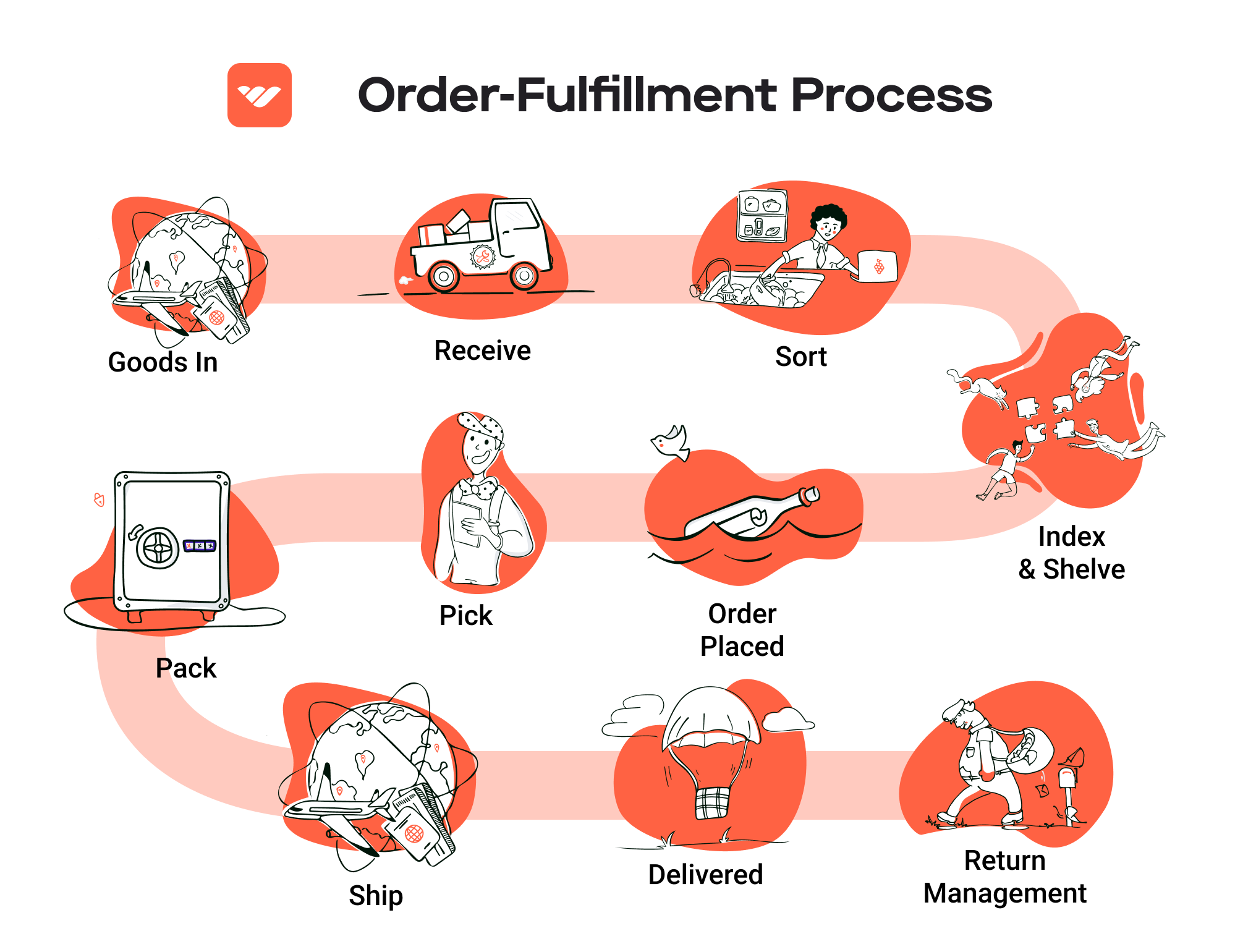
Key considerations during packing include selecting appropriate packaging materials and optimizing package dimensions to reduce shipping costs. “Pack lists” may also be used to verify that all items are included in the shipment. The packing process not only affects the safety of the items but also impacts customer satisfaction, as well-presented packages contribute to a positive unboxing experience.
5. Shipping & Delivery
The final step in the order fulfillment process is shipping and delivery. Once orders are packed, they are handed over to shipping carriers for delivery to the customer’s location. This stage is critical for ensuring that customers receive their orders on time and in good condition.
Businesses must choose the right shipping methods and carriers based on factors such as cost, speed, and reliability. Key terms associated with this step include “last mile delivery,” which refers to the final leg of the delivery journey from the distribution center to the customer’s door. Efficient shipping processes can lead to reduced costs and enhanced customer satisfaction, ultimately contributing to repeat business and positive reviews.
In conclusion, understanding and optimizing each step of the order fulfillment process—from receiving inventory to shipping and delivery—can significantly enhance the efficiency and effectiveness of e-commerce operations. By focusing on these critical components, businesses can scale their logistics capabilities and improve overall customer satisfaction.
Comparing Fulfillment Models: In-House vs. 3PL vs. Dropshipping
Fulfillment Model Comparison
| Model | Who Handles Inventory | Best For (Business Stage) | Key Advantage | Key Disadvantage |
|---|---|---|---|---|
| In-House Fulfillment | Business itself | Established businesses | Full control over inventory and branding | High overhead costs and complexity |
| Third-Party Logistics (3PL) | 3PL provider | Growing businesses | Scalability and reduced operational burden | Less control over inventory |
| Dropshipping | Supplier | Startups and small businesses | Low startup costs and no inventory risk | Lower profit margins and dependency on suppliers |
In-House Fulfillment
In-house fulfillment involves the business managing its own warehousing, inventory, and shipping processes. This model is typically favored by established businesses that have the resources to invest in a dedicated logistics team and infrastructure. One of the primary advantages of in-house fulfillment is the total control it offers over inventory management, order processing, and branding. Businesses can tailor their packaging, shipping, and customer service to align with their brand identity, leading to potentially enhanced customer experiences. However, this model also comes with significant overhead costs, including warehousing, staffing, and technology investments. Additionally, the complexity of managing logistics can become overwhelming, particularly during peak seasons, which may necessitate hiring additional staff or investing in automation solutions.
Third-Party Logistics (3PL)
Third-party logistics (3PL) is a model where businesses outsource their logistics and fulfillment processes to a specialized provider. This is particularly advantageous for growing businesses that may not have the capacity or expertise to manage logistics in-house. A key benefit of 3PL is scalability; as businesses grow, 3PL providers can adjust their services to meet increased demand without the business needing to invest in additional infrastructure. Furthermore, 3PL providers typically have established networks and expertise that can lead to cost savings in shipping and fulfillment. However, outsourcing logistics means relinquishing some control over inventory and fulfillment processes, which can lead to challenges in maintaining brand consistency and quality assurance. Businesses must carefully select a reputable 3PL partner to mitigate these risks.
Dropshipping
Dropshipping is a fulfillment model where the retailer does not hold inventory but instead transfers customer orders and shipment details directly to a manufacturer or wholesaler, who then ships the products directly to the customer. This model is particularly suited for startups and small businesses with limited capital, as it requires minimal upfront investment in inventory. The primary advantage of dropshipping is the low risk involved—businesses do not need to manage or store inventory, which reduces overhead costs significantly. However, this model often results in lower profit margins, as suppliers typically charge higher prices for their products. Additionally, businesses face dependency risks on suppliers for product quality and shipping timeliness, which can impact customer satisfaction and brand reputation. To succeed in dropshipping, businesses need to establish strong relationships with reliable suppliers and maintain clear communication regarding inventory levels and order fulfillment processes.
A Deep Dive into Amazon FBA: Pros, Cons, and Who It’s For
Understanding Fulfillment by Amazon (FBA)
Fulfillment by Amazon (FBA) is a service offered by Amazon that allows e-commerce sellers to store their products in Amazon’s fulfillment centers. Amazon then takes care of storage, packaging, shipping, and customer service on behalf of the sellers. This service is designed to simplify the logistics of selling online, enabling sellers to focus on growing their businesses while leveraging Amazon’s vast infrastructure.
How FBA Works
-
Product Preparation and Shipping: Sellers prepare their products according to Amazon’s requirements and ship them to one or more of Amazon’s fulfillment centers. Each product must be labeled correctly, and sellers need to ensure that their items comply with Amazon’s guidelines.
-
Storage: Once received, products are stored in Amazon’s warehouses. Sellers pay storage fees based on the volume of space their products occupy.
-
Order Fulfillment: When a customer places an order for a product that is fulfilled by Amazon, Amazon picks, packs, and ships the item directly to the customer. This process is designed to be efficient, ensuring quick delivery.
-
Customer Service: Amazon handles customer service inquiries related to FBA orders, including returns and refunds, allowing sellers to minimize their customer service workload.
-
Payment: After the product is sold, Amazon disburses the sale proceeds to the seller, deducting applicable fees for storage and fulfillment.
Pros of Using FBA
1. Prime Eligibility
One of the standout benefits of using FBA is that products become eligible for Amazon Prime. This status attracts millions of Prime members who prefer to buy items that offer fast, free shipping. As a result, sellers can potentially see a significant increase in sales volume.
2. Customer Trust
Products fulfilled by Amazon tend to enjoy higher levels of customer trust. Amazon’s reputation for reliable shipping and customer service can enhance the credibility of sellers. Customers are often more inclined to purchase from sellers using FBA, knowing that Amazon will handle shipping and returns.
3. Multi-Channel Fulfillment
FBA allows sellers to use Amazon’s fulfillment network for orders from other sales channels, such as their own websites or other marketplaces. This flexibility can streamline operations and logistics, allowing sellers to manage inventory more effectively across various platforms.
4. Increased Sales Potential
With access to Amazon’s vast marketplace and the benefits of Prime shipping, sellers can potentially reach a larger audience. The combination of visibility and trust can lead to increased sales and higher conversion rates.
5. Reduced Workload
By outsourcing logistics to Amazon, sellers can focus on other aspects of their business, such as marketing, product development, and customer engagement. This can lead to improved business efficiency and growth.
Cons of Using FBA
1. High Fees
While FBA offers many advantages, it comes with a range of fees that can add up quickly. Sellers are charged for storage, order fulfillment, and additional services like long-term storage fees for unsold items. These costs can significantly impact profit margins, especially for low-priced items.
2. Strict Inventory Rules
Amazon has stringent rules regarding inventory management, including performance metrics that sellers must meet. Sellers must monitor their inventory levels closely to avoid stockouts or excess inventory, which can lead to additional fees.
3. Commingling Risks
FBA uses a commingling system, where products from different sellers are stored together. This can pose risks, such as receiving returns from customers that were not originally sold by the seller. This situation can lead to complications in inventory tracking and potentially impact seller ratings.
4. Less Control Over Fulfillment
While outsourcing fulfillment can be beneficial, it also means sellers have less control over the packaging and shipping processes. Any issues with Amazon’s fulfillment centers, such as delays or errors, can directly affect customer satisfaction and seller reputation.
5. Complicated Returns Process
While Amazon handles returns, the process may not always align with a seller’s preferences or policies. Sellers might find it challenging to manage returns effectively, especially if they want to implement specific return policies or handle returns in a particular manner.
Who is FBA Best For?
Fulfillment by Amazon is particularly well-suited for:
-
Small to Medium-Sized Businesses: Entrepreneurs who want to scale their e-commerce operations without the burden of managing logistics can benefit from FBA.
-
Sellers with High Sales Volume: Those who expect to sell a high volume of products can leverage FBA’s efficiencies to manage order fulfillment effectively.
-
New Sellers: For those just starting out, FBA can simplify the logistics process, allowing them to focus on marketing and sales without worrying about fulfillment.
-
Brands Seeking Trust and Visibility: Sellers looking to build brand credibility and reach a larger audience can benefit from the visibility and trust associated with FBA.
-
Multi-Channel Sellers: Businesses that sell on multiple platforms can utilize FBA to manage their logistics more efficiently, streamlining their operations.
In conclusion, while FBA offers a robust solution for many e-commerce businesses, it’s essential for sellers to weigh the pros and cons carefully. Understanding the costs and operational requirements involved can help businesses make informed decisions on whether FBA aligns with their growth strategies and logistical needs.
Core Services Offered by Fulfillment Centers
Inventory Management & Warehousing
Inventory management and warehousing are foundational services provided by fulfillment centers, crucial for any e-commerce business aiming to streamline operations and reduce costs. This service involves the systematic tracking and organization of stock levels within a dedicated storage facility. Fulfillment centers utilize advanced inventory management software that integrates with e-commerce platforms, allowing businesses to monitor their inventory in real-time.
Benefits:
1. Optimized Stock Levels: By managing inventory effectively, businesses can avoid overstocking or stockouts, which can negatively impact customer satisfaction and sales.
2. Efficient Space Utilization: Fulfillment centers are designed to maximize storage space through strategic shelving and layout, ensuring that products are stored efficiently and can be accessed easily when needed.
3. Reduced Operational Costs: Outsourcing inventory management to a fulfillment center can significantly reduce overhead costs associated with maintaining a warehouse, including labor, utilities, and equipment.
Pick and Pack Services
Pick and pack services are at the heart of the fulfillment process. This service involves selecting items from the warehouse (picking) and preparing them for shipment (packing). Fulfillment centers employ a combination of technology and trained staff to ensure accuracy and efficiency during this process.
Benefits:
1. Faster Order Processing: With dedicated pick and pack teams, fulfillment centers can process orders quickly, reducing the time it takes for customers to receive their purchases. This agility is crucial in today’s fast-paced e-commerce environment.
2. Accuracy and Quality Control: Fulfillment centers implement strict quality control measures to minimize picking errors. This ensures that customers receive the correct items, leading to higher satisfaction and fewer returns.
3. Custom Packaging Options: Many fulfillment centers offer custom packaging solutions that enhance the unboxing experience for customers, which can be a significant factor in brand loyalty and repeat purchases.
Kitting and Assembly
Kitting and assembly services involve grouping multiple products together into a single package or creating a complete product from various components. This service is particularly beneficial for businesses that offer bundled products or require assembly before shipping.
Benefits:
1. Enhanced Product Offerings: By providing kitting services, fulfillment centers enable businesses to offer unique product bundles that can attract more customers and increase average order value.
2. Time Savings: Outsourcing kitting and assembly allows businesses to focus on core activities such as marketing and product development, rather than spending time on manual assembly tasks.
3. Streamlined Shipping: By shipping pre-assembled kits, businesses can reduce the complexity of their supply chain and improve shipping efficiency, leading to faster delivery times.
Returns Management (Reverse Logistics)
Returns management, often referred to as reverse logistics, is a critical service offered by fulfillment centers that involves handling product returns from customers. This process encompasses the return of goods, inspection, restocking, and processing refunds or exchanges.
Benefits:
1. Improved Customer Satisfaction: A well-managed returns process enhances customer trust and satisfaction. Fulfillment centers can handle returns efficiently, ensuring that customers receive prompt refunds or exchanges.
2. Data Insights: Returns management provides valuable data regarding product performance and customer preferences. Analyzing this information can help businesses make informed decisions about inventory and product offerings.
3. Cost-Effective Solutions: Outsourcing returns management to a fulfillment center can reduce the costs associated with handling returns in-house, such as labor and storage space for returned items.
Conclusion
In summary, fulfillment centers provide a suite of core services essential for scaling e-commerce operations. From inventory management and warehousing to pick and pack services, kitting and assembly, and returns management, these centers play a pivotal role in enhancing operational efficiency, customer satisfaction, and overall business growth. By leveraging these services, e-commerce businesses can focus on their core competencies while ensuring a seamless logistics experience for their customers.
How to Choose a Fulfillment Partner: A 6-Point Checklist
Location & Warehouse Network
Importance:
The location of a fulfillment center is critical to your logistics strategy. Proximity to your target markets can significantly reduce shipping times and costs, enhancing customer satisfaction. A well-distributed warehouse network allows for efficient order processing and better inventory management.
Questions to Ask:
– Where are your fulfillment centers located, and how do these locations align with my primary customer demographics?
– What is your average shipping time to major markets?
– Do you have multiple warehouses, and how do you determine which warehouse will fulfill an order?
Technology & Integrations
Importance:
In today’s e-commerce landscape, technology plays a pivotal role in streamlining operations. A fulfillment partner should offer advanced technology solutions, such as inventory management systems, order tracking, and real-time analytics. The ability to integrate these technologies with your existing platforms (like your e-commerce site) is crucial for seamless operations.
Questions to Ask:
– What technology platforms do you use for order management and inventory tracking?
– Can your systems integrate with my e-commerce platform (e.g., Shopify, Magento)?
– How do you handle data security and compliance, especially concerning customer information?
Specializations (e.g., Cold Storage, Oversized Items)
Importance:
Depending on your product range, you may require a fulfillment partner with specific capabilities, such as cold storage for perishable goods or special handling for oversized items. Understanding their specializations can help ensure that your products are stored and shipped appropriately, maintaining quality and compliance with regulations.
Questions to Ask:
– What types of products do you specialize in handling?
– Do you have facilities for specialized storage needs, such as temperature-controlled environments?
– How do you manage the unique requirements of different product types, and what protocols do you have in place?
Scalability & Capacity
Importance:
As your business grows, your fulfillment needs will likely change. A good fulfillment partner should have the capacity to scale operations in response to increased order volume, seasonal spikes, or new product launches. Understanding their scalability can help you avoid disruptions in service as you expand.
Questions to Ask:
– What is your capacity for handling increased order volume during peak seasons?
– How quickly can you scale operations if my business experiences rapid growth?
– Can you support additional services, such as kitting or bundling, as my product offerings evolve?
Pricing and Contracts
Importance:
Cost is a significant factor in selecting a fulfillment partner. It’s essential to understand the pricing structure, including any hidden fees, minimum order requirements, and contract terms. A transparent pricing model helps you budget effectively and avoid unexpected costs.
Questions to Ask:
– What is your pricing structure for storage, order fulfillment, and shipping?
– Are there any additional fees for services like returns processing or inventory management?
– What are the terms of your contract, and is there flexibility for renegotiation as my business changes?
Customer Support & Reviews
Importance:
Reliable customer support is crucial when issues arise, whether related to order fulfillment, inventory discrepancies, or technology integration. Additionally, researching reviews and testimonials can provide insight into the partner’s reliability and service quality.
Questions to Ask:
– What kind of customer support do you offer (e.g., dedicated account manager, 24/7 support)?
– How do you handle issues or complaints, and what is your typical response time?
– Can you provide references or case studies from current clients in my industry?
Conclusion
Choosing the right fulfillment partner is a critical decision that can influence your business’s efficiency and customer satisfaction. By utilizing this checklist, you can assess potential partners systematically, ensuring that they align with your operational needs and growth ambitions. Remember, the right partner should not only meet your current requirements but also support your future scalability and success in the competitive e-commerce landscape.
Understanding Fulfillment Pricing: A Breakdown of Common Fees
Initial Setup Fees
Initial setup fees are the costs incurred when first establishing your account with a fulfillment center. These fees can include costs associated with onboarding, system integration, and initial inventory setup. For many e-commerce businesses, this is a one-time cost that can vary widely depending on the complexity of the integration and the volume of initial inventory being stored.
Typically, the calculation of initial setup fees involves:
– Account Setup: A flat fee for creating your account and integrating your systems with the fulfillment provider’s technology.
– Inventory Upload: Charges based on the number of SKUs you wish to upload into the system, often calculated on a per-item basis.
– Training and Support: If the provider offers onboarding training for your team, this may also factor into the setup costs.
To minimize initial setup fees, consider negotiating these costs upfront, especially if you plan on a long-term relationship with the fulfillment center.
Receiving Fees
Receiving fees are charged when the fulfillment center receives and processes your inventory. This fee typically covers the labor and resources required to unload, inspect, and store your products. The calculation of receiving fees often depends on several factors:
– Volume of Inventory: Charges may be based on the number of pallets or boxes received.
– Inspection and Sorting: If your products require special handling or quality checks, additional fees may apply.
– Time Taken: Some providers charge based on the time it takes to receive and process the inventory, particularly if the volume is high.
To keep receiving fees manageable, ensure your shipments are organized and labeled correctly, and consider scheduling deliveries during off-peak times.
Storage Fees (per pallet/bin)
Storage fees are charged for the space your inventory occupies within the fulfillment center. These fees are typically calculated on a monthly basis and can be based on the number of pallets or bins your products occupy. The calculation is usually determined by:
– Storage Type: Rates can vary depending on whether you require standard storage, climate-controlled storage, or special handling.
– Duration of Storage: Longer storage durations may incur higher rates, especially if your inventory is not moving quickly.
To optimize storage fees, regularly analyze your inventory turnover rates and remove slow-moving items from storage. Some fulfillment centers also offer tiered pricing, where the cost per pallet decreases with increased storage volume.
Pick & Pack Fees (per item/order)
Pick and pack fees are charged for the process of selecting items from inventory and packing them for shipment. This fee is crucial for e-commerce businesses, as it directly impacts order fulfillment costs. The calculation of pick and pack fees typically includes:
– Per-Item Fee: A charge for each item picked from storage, which can vary based on the complexity of the pick.
– Per-Order Fee: A flat fee for each order that requires packing, regardless of the number of items.
– Special Packaging: If your items require special packaging or handling, additional fees may apply.
To manage pick and pack fees effectively, streamline your product offerings and utilize efficient inventory management practices to minimize the number of picks required.
Shipping Fees
Shipping fees are the costs associated with transporting orders from the fulfillment center to the customer. These fees can vary significantly based on several factors, including:
– Shipping Method: Costs differ based on whether you choose standard, expedited, or same-day shipping options.
– Destination: Shipping fees vary based on the distance to the delivery address, with international shipping typically incurring higher costs.
– Package Dimensions and Weight: Carriers often charge based on the weight and size of the package, so optimizing packaging can lead to savings.
To reduce shipping fees, consider negotiating contracts with carriers or using fulfillment centers that have established relationships with shipping companies to access discounted rates.
Conclusion: Tips for Getting an Accurate Quote
To get an accurate quote for fulfillment services, follow these practical tips:
- Provide Detailed Information: Clearly outline your inventory types, expected order volumes, and specific fulfillment needs to ensure the provider can give you a precise estimate.
- Ask About All Fees: Inquire about all potential fees, including hidden costs that may not be immediately apparent, such as chargebacks or returns processing.
- Compare Multiple Providers: Reach out to several fulfillment centers to compare their pricing structures and services. This will help you identify the best fit for your business.
- Negotiate Terms: Don’t hesitate to negotiate terms and pricing, especially if you plan to scale your business significantly in the future.
- Review Contracts Carefully: Before signing, ensure you understand all terms, conditions, and fees outlined in the contract.
By understanding these common fulfillment pricing models and following these tips, you can effectively manage your fulfillment costs and streamline your e-commerce operations.
Frequently Asked Questions (FAQs) about Fulfillment
1. What is the Amazon Fulfillment Center-LAS7?
The Amazon Fulfillment Center-LAS7 is a large-scale distribution facility located in Las Vegas, Nevada. It specializes in storing, packing, and shipping a wide variety of products for Amazon’s e-commerce operations. This center plays a critical role in ensuring timely delivery to customers, supporting Amazon’s commitment to fast and reliable service.
2. How does the LAS7 fulfillment center improve order processing efficiency?
LAS7 employs advanced technology and streamlined processes to enhance order fulfillment efficiency. Automated systems are utilized for sorting and packing, which minimizes handling time and reduces errors. The facility also benefits from a well-trained workforce dedicated to maintaining high operational standards.
3. What types of products are processed at the LAS7 fulfillment center?
The LAS7 fulfillment center handles a broad range of products, from electronics and household items to clothing and specialty goods. Its capabilities are designed to accommodate various categories, ensuring that it can meet diverse customer demands across the Amazon marketplace.
4. What is the difference between a warehouse and a fulfillment center?
A warehouse primarily focuses on storing goods, whereas a fulfillment center is designed for order processing, packing, and shipping. Fulfillment centers often incorporate advanced logistics technology and systems to facilitate quick and accurate order fulfillment, making them essential for e-commerce operations.
5. What is a Third-Party Logistics Provider (3PL)?
A Third-Party Logistics Provider (3PL) is a service that manages logistics operations for businesses, including warehousing, inventory management, order fulfillment, and shipping. By partnering with a 3PL, businesses can focus on core activities while leveraging the expertise and resources of a logistics specialist.
6. How much do fulfillment services cost?
The cost of fulfillment services can vary widely based on factors such as order volume, types of products, storage requirements, and the level of service needed. Typically, costs may include storage fees, picking and packing fees, shipping fees, and any additional services like returns processing. It’s essential for businesses to assess their specific needs to get accurate pricing.
7. Can I visit the LAS7 fulfillment center for a tour?
Yes, Amazon offers tours of the LAS7 fulfillment center, providing visitors with an inside look at the operations and logistics processes. Tours typically last about an hour and are available on weekdays. However, it is advisable to check for availability and any potential restrictions before planning your visit.
8. How does Amazon ensure the security of products at the LAS7 facility?
Amazon employs stringent security measures at the LAS7 fulfillment center, including surveillance systems, access controls, and employee training programs. These measures help safeguard products throughout the storage and fulfillment process, ensuring that customer orders are handled securely.
9. What technologies are used in the LAS7 fulfillment center?
The LAS7 fulfillment center utilizes a variety of technologies, including automated sorting systems, inventory management software, and robotics for packing and shipping. These technologies work together to optimize the fulfillment process, increase accuracy, and reduce processing times.
10. How can partnering with the LAS7 fulfillment center benefit my e-commerce business?
Partnering with the LAS7 fulfillment center can significantly enhance your e-commerce operations by providing access to Amazon’s extensive logistics network. This can lead to faster shipping times, improved order accuracy, and the ability to scale your operations without the overhead of managing your own fulfillment process. Additionally, leveraging Amazon’s reputation for reliability can enhance customer satisfaction.
Conclusion: Is Outsourcing Fulfillment the Right Move for Your Business?
Evaluating the Benefits of Outsourcing Fulfillment
Outsourcing your fulfillment can be a game-changer for your e-commerce business. One of the most significant advantages is time savings. By leveraging a fulfillment service, you can redirect your focus from the complexities of logistics to core business functions such as marketing, product development, and customer service. This shift allows you to enhance your operational efficiency and ultimately drive sales growth.
Scalability is another critical benefit. As your business expands, so do your fulfillment needs. A robust fulfillment partner can easily adjust to fluctuations in order volume, seasonal spikes, or new product launches. This flexibility ensures that you can scale your operations without the burden of managing additional warehousing and staffing complexities. In a rapidly changing market, being able to respond quickly to demand is vital for maintaining a competitive edge.
Moreover, partnering with a fulfillment expert brings a wealth of industry knowledge and best practices. These providers are equipped with the latest technology and processes, ensuring that your orders are processed accurately and delivered on time. This expertise not only enhances customer satisfaction but can also lead to cost savings through optimized shipping strategies.
However, it’s crucial to choose the right fulfillment partner. Conduct thorough research, evaluate potential providers based on their capabilities, customer service, and technology infrastructure. A well-aligned partner can significantly contribute to your growth trajectory.
Take Action
Now is the time to assess your current shipping and fulfillment processes. Conduct an audit to identify pain points, inefficiencies, and areas for improvement. Consider whether outsourcing fulfillment could streamline your operations and support your growth objectives. By making informed decisions today, you can position your business for success in the competitive e-commerce landscape.
Important Disclaimer
⚠️ Important Disclaimer
The information in this guide is for educational purposes. Fulfillment services, pricing, and platform features change frequently. Always conduct your own due diligence and consult with providers directly before making business decisions.
